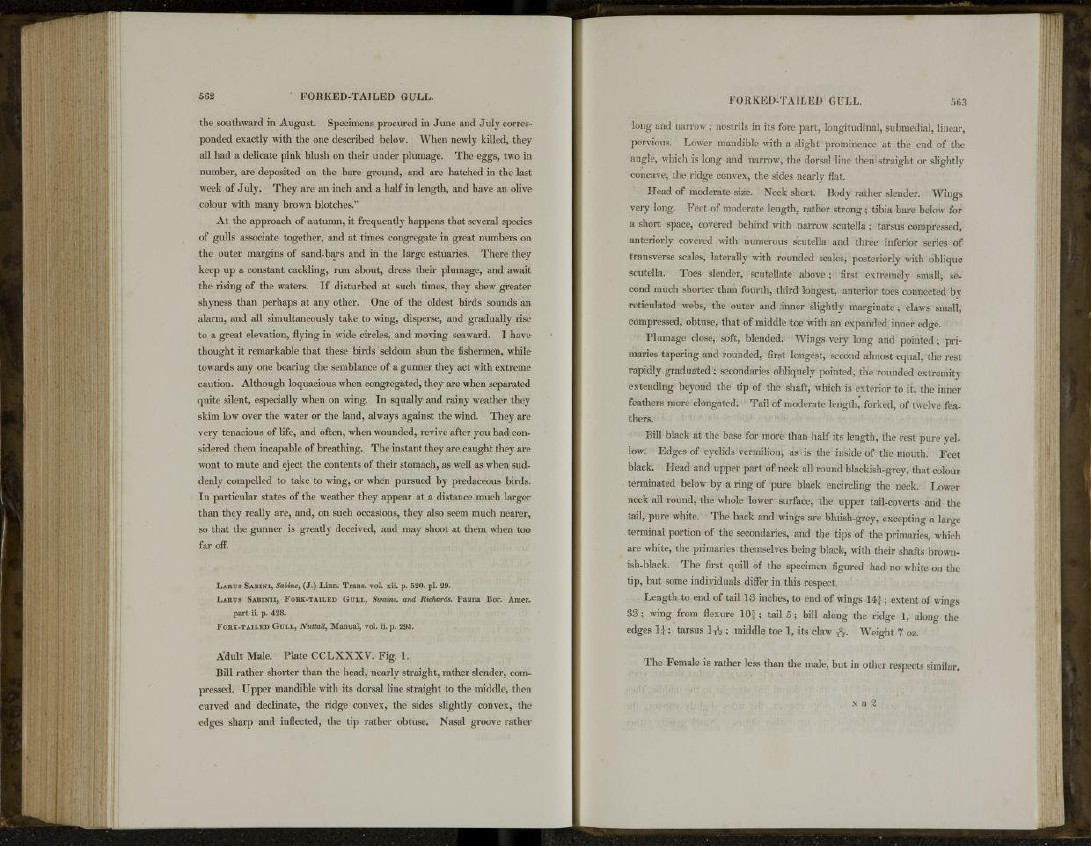
the southward in August. Specimens procured in June and July corresponded
exactly with the one described below. When newly killed, they
all had a delicate pink blush on their under plumage. The eggs, two in
number, are deposited on the bare ground, and are hatched in the last
week of July. They are an inch and a half in length, and have an olive
colour with many brown blotches.'1
At the approach of autumn, it frequently happens that several species
of gulls associate together, and at times congregate in great numbers on
the outer margins of sand-bars and in the large estuaries. There they
keep up a constant cackling, run about, dress their plumage, and await
the rising of the waters. If disturbed at such times, they shew greater
shyness than perhaps at any other. One of the oldest birds sounds an
alarm, and all simultaneously take to wing, disperse, and gradually rise
to a great elevation, flying in wide circles, and moving seaward. I have
thought it remarkable that these birds seldom shun the fishermen, while
towards any one bearing the semblance of a gunner they act with extreme
caution. Although loquacious when congregated, they are when separated
quite silent, especially when on wing. In squally and rainy weather they
skim low over the water or the land, always against the wind. They are
very tenacious of life, and often, when wounded, revive after you had considered
them incapable of breathing. The instant they are caught they are
wont to mute and eject the contents of their stomach, as well as when suddenly
compelled to take to wing, or when pursued by predaceous birds-
In particular states of the weather they appear at a distance much larger
than they really are, and, on such occasions, they also seem much nearer,
so that the gunner is greatly deceived, and may shoot at them when too
far off.
LARUS SABINI, Sabine, ( J . ) Linn. Trans, vol. xii. p. 5 2 0 . pi. 2 9 .
LARUS SABINII, FORK-TAILED GULL, Swains, and Richards. Fauna Bor. Amer.
part ii. p. 4 2 8 .
FORK-TAILED GULL, Nnttall, Manual, vol. ii. p. 2 9 5 .
Adult Male. Plate CCLXXXV. Fig. 1.
Bill rather shorter than the head, nearly straight, rather slender, compressed.
Upper mandible with its dorsal line straight to the middle, then
curved and declinate, the ridge convex, the sides slightly convex, the
edges sharp and inflected, the tip rather obtuse. Nasal groove rather
long and narrow ; nostrils in its fore part, longitudinal, submedial, linear,
pervious. Lower mandible with a slight prominence at the end of the
angle, which is long and narrow, the dorsal line then straight or slightly
concave, the ridge convex, the sides nearly flat.
Head of moderate size. Neck short. Body rather slender. Wings
very long. Feet of moderate length, rather strong ; tibia bare below for
a short space, covered behind with narrow scutella; tarsus compressed,
anteriorly covered with numerous scutella and three inferior series of
transverse scales, laterally with rounded scales, posteriorly with oblique
scutella. Toes slender, scutellate above ; first extremely small, second
much shorter than fourth, third longest, anterior toes connected by
reticulated webs, the outer and inner slightly margínate; claws small,
compressed, obtuse, that of middle toe with an expanded inner edge.
Plumage close, soft, blended. Wings very long and pointed; primaries
tapering and rounded, first longest, second almost equal, the rest
rapidly graduated ; secondaries obliquely pointed, the rounded extremity
extending beyond the tip of the shaft, which is exterior to it. the inner
feathers more elongated. Tail of moderate length, forked, of twelve feathers.
Bill black at the base for more than half its length, the rest pure yellow.
Edges of eyelids vermilion, as is the inside of the mouth. Feet
black. Head and upper part of neck all round blackish-grey, that colour
terminated below by a ring of pure black encircling the neck. Lower
neck all round, the whole lower surface, the upper tail-coverts and the
tail, pure white. The back and wings are bluish-grey, excepting a large
terminal portion of the secondaries, and the tips of the primaries, which
arc white, the primaries themselves being black, with their shafts brownish
black. The first quill of the specimen figured had no white on the
tip, but some individuals differ in this respect.
Length to end of tail 13 inches, to end of wings 14} ; extent of wings
33; wing from flexure 10] ; tail 5; bill along the ridge 1, along the
edges l j ; tarsus 15
2 ; middle toe 1, its claw j%. Weight 7 oz.
T
The Female is rather less than the male, but in other respects similar.
N n 2